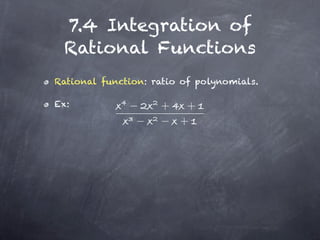
Calculus II - 4
- 1. 7.4 Integration of Rational Functions Rational function: ratio of polynomials. Ex: + + +
- 2. 7.4 Integration of Rational Functions Rational function: ratio of polynomials. Ex: + + + Fact: A rational function can always be decomposed to summation of terms like + polynomials or ( + ) or ( + + ) where A, B, etc. are constants. Ex: − + + = + + + − − − + − ( − ) + Partial Fractions
- 3. First step: if the rational function is improper (the degree of numerator is more than or equal to the degree of dominator), use long division to decompose it to a polynomial plus a proper rational function. + Ex: = + + +
- 4. First step: if the rational function is improper (the degree of numerator is more than or equal to the degree of dominator), use long division to decompose it to a polynomial plus a proper rational function. + Ex: = + + + As a result: + = + + + | |+
- 5. Second step: factor the dominator of the proper rational function to be a product of linear factors and/or irreducible quadratic factors. + + is irreducible if < . Ex: + = ( + ) + = ( )( + ) + + =( ) ( + )
- 6. Third step: decompose the proper rational function to be a sum of partial fractions by method of undetermined coefficients. + Ex: +
- 7. Third step: decompose the proper rational function to be a sum of partial fractions by method of undetermined coefficients. + Ex: + We factor + = ( )( + )
- 8. Third step: decompose the proper rational function to be a sum of partial fractions by method of undetermined coefficients. + Ex: + We factor + = ( )( + ) + so assume = + + + +
- 9. Third step: decompose the proper rational function to be a sum of partial fractions by method of undetermined coefficients. + Ex: + We factor + = ( )( + ) + so assume = + + + + ( + + ) +( + ) = +
- 10. Third step: decompose the proper rational function to be a sum of partial fractions by method of undetermined coefficients. + Ex: + We factor + = ( )( + ) + so assume = + + + + ( + + ) +( + ) = + thus = , = , =
- 11. CASE I: the dominator is a product of distinct linear factors. CASE II: the dominator is a product of linear factors, some of which are repeated. CASE III: the dominator contains distinct irreducible quadratic factors. Case IV: the dominator contains repeated irreducible quadratic factors.
- 12. + Ex: find +
- 13. + Ex: find + We already knew that + = + + ( ) ( + ) C AS E I
- 14. + Ex: find + We already knew that + = + + ( ) ( + ) + C AS E I so + = | |+ | | | + |+
- 15. Ex: find +
- 16. Ex: find + We factor that + =( ) ( + ) CAS E II
- 17. Ex: find + We factor that + =( ) ( + ) CAS E II so we assume = + + + ( ) +
- 18. Ex: find + We factor that + =( ) ( + ) CAS E II so we assume = + + + ( ) + and find = , = , =
- 19. Ex: find + We factor that + =( ) ( + ) CAS E II so we assume = + + + ( ) + and find = , = , = thus + = | | | + |+
Hinweis der Redaktion
- \n
- \n
- \n
- \n
- \n
- \n
- \n
- \n
- \n
- \n
- \n
- \n
- \n
- \n
- \n
- \n
- \n
- \n
- \n
- \n
- \n
- \n
- \n
- \n
- \n
- \n
- \n
- \n
- \n
- \n
- \n
- \n
- \n
